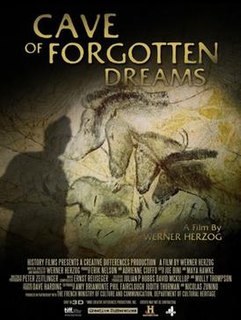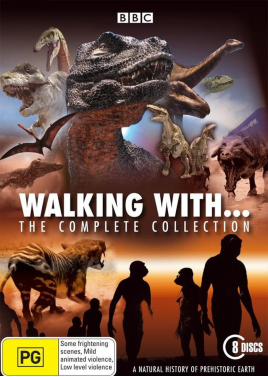 W
WApe to Man is a dramatised documentary on the scientific community’s journey to find the missing link in human evolution, between our ancestors the apes and modern man today.
 W
WBritish Isles – A Natural History is an eight-part documentary series produced by the BBC Natural History Unit and presented by Alan Titchmarsh. Originally broadcast in the UK on BBC1 from September to November 2004, it took viewers on a journey from the formation of what is now the British Isles some 3 billion years ago to the present day, revealing how natural and human forces have shaped the landscape. Each of the 50-minute episodes was followed by a 10-minute short specific to each region of the British Isles. In 2007, the BBC made a companion series about British wildlife called The Nature of Britain, also presented by Titchmarsh.
 W
WCave of Forgotten Dreams is a 2010 3D documentary film by Werner Herzog about the Chauvet Cave in southern France, which contains some of the oldest human-painted images yet discovered. Some of them were crafted around 32,000 years ago. The film premiered at the 2010 Toronto International Film Festival and consists of images from inside the cave as well as of interviews with various scientists and historians. The film also includes footage of the nearby Pont d'Arc natural bridge.
 W
WDawn of Humanity is a 2015 American documentary film that was released online on September 10, 2015, and aired nationwide in the United States on September 16, 2015. The PBS NOVA National Geographic film, in one episode of two hours, was directed and produced by Graham Townsley. The film describes the 2013 discovery, and later excavation, of the fossil remains of Homo naledi, an extinct species of hominin assigned to the genus Homo, found within the Dinaledi Chamber of the Rising Star Cave system, located in the Cradle of Humankind, South Africa. Additionally, the National Geographic Society has multiple videos on its website covering different phases of the discovery and excavation of the fossils during a two-year period. As of September 2015, fossils of at least fifteen individuals, amounting to 1550 specimens, have been excavated from the cave.
 W
WGenesis 2.0 is a documentary film made by Swiss director and producer Christian Frei and Russian filmmaker Maxim Abugaev. The feature-length film was released in January 2018 in the World Cinema Documentary section at the Sundance Film Festival. At the center of the film is the woolly mammoth, an extinct and iconic species that today is surrounded by wishes and visions. On the one hand, the film documents the hazardous daily lives of a group of men who gather valuable mammoth tusks in a remote archipelago, the New Siberian Islands. On the other, it illuminates the potential of genetic research and synthetic biology — the means by which researchers hope to bring the woolly mammoth back to life.
 W
WIce People is a documentary film directed by Anne Aghion about the research of Allan Ashworth and Adam Lewis in Antarctica. Produced by Dry Valleys Productions, this 2008 film portrays the scientists discovering fossils from 13.9 million years ago. The film premiered at the San Francisco International Film Festival in April 2008 and was screened at the Jerusalem Film Festival in July 2008. This film aired on Sundance Channel in 2009.
 W
WThe Incredible Human Journey is a five-episode, 300 minute, science documentary film presented by Alice Roberts, based on her book by the same name. The film was first broadcast on BBC television in May and June 2009 in the UK. It explains the evidence for the theory of early human migrations out of Africa and subsequently around the world, supporting the Out of Africa Theory. This theory claims that all modern humans are descended from anatomically modern African Homo sapiens rather than from the more archaic European and Middle Eastern Homo neanderthalensis or the indigenous Chinese Homo pekinensis, and that the modern African Homo sapiens did not interbreed with the other species of genus Homo.
 W
WLost Worlds, Vanished Lives is a 1989 four-part BBC documentary series concerning the discovery of fossils. It is written and presented by David Attenborough, produced by Mike Salisbury, and was originally broadcast in April 1989. It was made in between the second and third instalments of Attenborough's "Life" series: The Living Planet and The Trials of Life, respectively. The study of rocks and their ancient secrets was something of a boyhood passion for David Attenborough. In these programmes, his enthusiasm for the subject is undiminished. With the help of expert palaeontologists, fossil hunters and modern animation techniques, Attenborough attempts to show how life evolved in Earth's distant past. To do so, he travels the globe to visit the world's most famous fossil sites.
 W
WPrehistoric Autopsy is a 2012 British television documentary film series shown in three one-hour episodes on BBC Two. The series is about human evolution and is narrated by biologist George McGavin and anatomist Alice Roberts. Graeme Thomson is the series producer and Jane Aldous is the executive producer.
 W
WPrehistoric Park is a six-part docu-fiction television mini-series that premiered on ITV on 22 July 2006 and on Animal Planet on 29 October 2006. The programme was produced by Impossible Pictures, who also created Walking with Dinosaurs. Each episode is an hour long including commercial breaks. Repeats of the show are broadcast in the UK on Watch.
 W
WWalking with..., also referred to as Walking with Prehistoric Life, is a media franchise created by Tim Haines and Jasper James centered on a collection of documentary series produced by the BBC and created by the independent production company Impossible Pictures. The series of documentaries began with Walking with Dinosaurs (1999), which was followed by four more series; Walking with Beasts (2001), Walking with Cavemen (2003), Sea Monsters (2003) and Walking with Monsters (2005).
 W
WSea Monsters, marketed as Chased by Sea Monsters in the United States, is a 2003 three-part nature documentary television miniseries created by Impossible Pictures and produced by the BBC Natural History Unit, the Discovery Channel and ProSieben. Following in the footsteps of The Giant Claw (2002) and Land of Giants (2003), special episodes of the nature documentary series Walking with Dinosaurs, Sea Monsters stars British wildlife presenter Nigel Marven as a "time-travelling zoologist" who travels to seven different periods of time in prehistory, diving in the "seven deadliest seas of all time" and encountering and interacting with the prehistoric creatures who inhabit them. The series is narrated by Karen Hayley.
 W
WSea Monsters: A Prehistoric Adventure is a 2007 American IMAX 3D documentary film by National Geographic, about prehistoric marine reptiles. It alternates modern-day sequences about the work of scientists studying the animals with computer-animated scenes depicting the prehistoric past.
 W
WSea Rex 3D: Journey to a Prehistoric World is a 3D film released to IMAX theaters in 2010. It was released on Blu-ray and Blu-ray 3D in November, 2011.
 W
WA Species Odyssey is a French documentary film directed by Jacques Malaterre, first broadcast on January 7, 2003 on France 3.
 W
WUncovering Our Earliest Ancestor: The Link is a one-hour television documentary made by Atlantic Productions for the BBC, first aired on 26 May 2009 on BBC One. It explores the story behind the discovery of an early primate fossil, Darwinius masillae, nicknamed Ida, in a shale quarry in Germany. The fossil is believed to be around 47 million years old, and is extraordinarily well-preserved. Originally unearthed in 1983, Ida lay in the hands of a private collector for 20 years before it was shown to a Norwegian paleontologist, Dr Jørn Hurum. Realising that Ida could turn out to be a significant missing link between modern primates, lemurs and lower mammals, he persuaded the Natural History Museum in Oslo to purchase the fossil and assembled an international team of experts to study it. Their findings were announced in a press conference and the online publication of a scientific paper on 19 May 2009.
 W
WWalking with Beasts is a 2001 six-part television documentary miniseries, produced by the BBC Natural History Unit. It is the second installment of the Walking With... series and a sequel to Walking with Dinosaurs. Beasts takes place after the extinction of the non-avian dinosaurs 65 million years ago depicted in Walking with Dinosaurs, and recreates animals of the Cenozoic with computer-generated imagery and animatronics. Like Dinosaurs, its narrative is presented in the style of a traditional nature documentary. Some of the concepts it illustrates are the evolution of whales, horses, elephants and humans.
 W
WWalking with Cavemen is a four-part television documentary series about human evolution produced by the BBC in the United Kingdom. It was originally released in March 2003. It was subsequently presented in the United States as a two-part series by the Discovery Channel and its affiliates. There was an accompanying book of the same title. The documentary was also published by BBC in 2004 as a two part documentary of 50 minutes each and was narrated by Andrew Sachs.
 W
WWalking with..., also referred to as Walking with Prehistoric Life, is a media franchise created by Tim Haines and Jasper James centered on a collection of documentary series produced by the BBC and created by the independent production company Impossible Pictures. The series of documentaries began with Walking with Dinosaurs (1999), which was followed by four more series; Walking with Beasts (2001), Walking with Cavemen (2003), Sea Monsters (2003) and Walking with Monsters (2005).
 W
WWild New World is a six-part BBC documentary series about Ice Age America that describes the prehistory, landscape and wildlife of the continent from the arrival of humans to the end of the Ice Age. It was first transmitted in the UK on BBC Two from 3 October to 7 November 2002. Like several other BBC programmes, it contains both computer graphics and real-life animals. Occasionally, footage of non-American counterparts of the extinct North American beasts are used in juxtaposition with footage of native American animals, like the pronghorn.